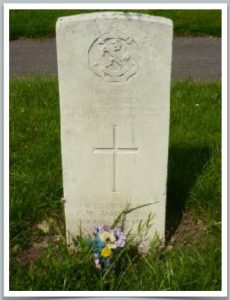1st Home Service Battalion, Royal West Kent Regiment

Francis William James was born in Cirencester in 1882 and Frank as he appears to have been known, is unusual in that after volunteering his services early in the war and being discharged, as medically unfit, he was re-engaged after a relatively short time.
His parents were Francis William James (1856-1931) and his wife Alice (née Stratford: 1860-1937). The couple appeared to have had fifteen children (the 1911 Census says 14, with one pre-1911 death), with Frank being the eldest son.
Francis William (senior) was a bricklayers/stone mason. In 1891 the family lived at Poulton, a village on the road from Cirencester to Fairford and by 1901 they had re-located to The Quarries, Siddington, a village just south of Cirencester. At that time Frank was aged 19 and working as a farm labourer.
On 1 July 1907 Frank married Emily Daisy Robbins at Cirencester and the couple went on to have three children, Francis Walter (born 31 January 1908); Lillian Mary (born 23 June 1911) and Albert George (born 4 May 1913).
At the time of the 1911 Census the couple were living at The Quarries, Siddington and Frank was recorded as being employed as a bricklayer. The census record shows them to have had two children by then of whom one was deceased.
Thanks to the survival of his Army Pension Record we have a good insight into Frank’s military service. He enlisted into the Army Special Reserve at Cirencester on 19 October 1914, undertaking to serve for a period of a year. He stated his age to be 31 years 124 days and his occupation as a mason.
He was assigned to the 3rd (Reserve) Battalion. He was given the number 3251 and served for just 191 days before being discharged, on 27 April 1915, as ‘medically unfit’, reason unknown: presumably he did not measure up to what would be the physical demands of front line service.
According to an attestation form contained in his pension records, he applied to re-join the Army on 2 August 1915, for the duration of the war. He gave his address as 8 Gas Lane, Cirencester and his occupation as a mason.
A ‘statement of service’ within the pension papers indicates that he re-joined the 3rd (Reserve) Battalion of the Glosters on 15 October 1915, was given the number 23651 and appointed as an unpaid Lance Corporal.
It would appear that Frank was never destined to serve abroad. In March 1916 the 1st Home Service Garrison Battalion of the Royal West Kent Regiment was formed in Rochester.
On 24 March 1916 Frank was transferred to the unit and was given a new number, G/13588. On 1 April 1916 he was appointed acting Lance Corporal. However, this rank was taken away from him on 28 December 1916, along with six days pay for going absent without leave.
On 24 April 1917 he was discharged as ‘no longer fit for war service’. This was due to sickness and a note in the pension papers states that he was suffering from pulmonary tuberculosis. His second spell in the Army had lasted one year and 266 days.
He was granted a disability pension, reviewable six monthly.
Francis William James died on 5 November 1918 at Cirencester, aged 35. A recently released Pension Record Card states he ‘Died of Disease’ and almost certainly this was pulmonary tuberculosis, for which, in those days, effective treatment was very limited.
He was buried in Cirencester (Chesterton) Cemetery on 9 November 1918 and a standard CWGC headstone now marks his grave.
His widow, Emily, remarried in the second half of 1922, interestingly to a man 13 years her junior.
Two of Frank’s brothers were also to die during the war. Lance Corporal Albert James (9261), serving with the 2nd Glosters was killed in action on 18 February 1915 at Ypres.
He has no known grave and iD commemorated on the Memorial to the Missing at the Menin Gate.
Private Walter James (29995) was serving with the 2/5th Glosters, when he went missing in action on 18 April 1918 during the German Spring Offensive.
He has no known grave and is commemorated on the Loos Memorial to the Missing at Dud Corner. This memorial carries the names of all those with no known grave who fell in the area and not just those from the Battle of Loos in September/October 1915.
Researched by Graham Adams 30 April 2021
